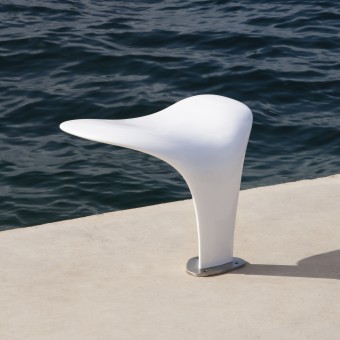Whale Tail Sitting Bench by Enrique Minguez |
Home > Winners > #118288 |
 |
|
||||
| DESIGN DETAILS | |||||
| DESIGN NAME: Whale Tail PRIMARY FUNCTION: Sitting Bench INSPIRATION: This piece of furniture takes its inspiration from the ocean and one of the most iconic images it offers us: the whale tails. UNIQUE PROPERTIES / PROJECT DESCRIPTION: This single support design, allows for elegance and sobriety in both urban and natural environments. It can be placed either by itself or in small groups, enabling the seating space to resemble the vision of a single whale or of a whole pod swimming in harmony. It allows for different options in use of materials. It can be made of fiberglass reinforced either with wood or concrete. Yet, in its most environmentally efficient version, it can also be made of fiberglass reinforced with concrete and recycled plastic. All of these combinations enable the seat to follow a clean and ergonomic shape. Depending on the materials chosen it can resist up to 310kg. OPERATION / FLOW / INTERACTION: Sitting bench. This piece not only fulfils the function of a seat, it also provides an aesthetic value when it is placed in the urban space: seafronts, ports, parks, squares, streets and boulevards. When t it is not occupied, its soft undulating shapes make it a sculptural element. PROJECT DURATION AND LOCATION: The project started in September 2019 and finished in March 2020 in Cartagena (Spain), and it was exhibited in the port of Cartagena in June 2020. Currently it has been proposed for a large-area shopping center. |
PRODUCTION / REALIZATION TECHNOLOGY: It can be made from three different processes: A. Fiberglass reinforced with wood. Fiberglass painted thick between 8 and 12 mm. Interior reinforced with high density compact laminated wood frame. B. Fiberglass with reinforced concrete and recycled plastic. Fiberglass painted thick between 4 and 8 mm. Interior reinforced with polymer concrete and recycled HPDE. C. Reinforced concrete. Concrete finish, reinforced with fibers of very high performance and great plasticity, which gives it great resistance. SPECIFICATIONS / TECHNICAL PROPERTIES: The maximum measures are 80cm width, 54cm depth and 51cm height. The width varies in a smooth transition from the tail (seat) of 80 cm to the neck of the tail (base) of just 16 cm. TAGS: WhaleTailBench, WhaleTail, Bench, SeaBench, PortBench, Seafront RESEARCH ABSTRACT: The type of research used was data collection by observation, as the main objective was to create a piece based on marine life. Design Thinking Methodology was then used to ensure that ergonomics was present, but always framed by the connection to the sea. Bearing that in mind, whales, dolphins, seahorses, waves and other remarkable marine items were studied to abstract their basic shapes. The aim was to establish a relationship between those shapes and the forms produced by the human body, in search of a practical figure. After some failed initial creations, the focus turned to capturing the aerodynamic and organic essence of the marine environment. Thus, it was concluded that the tail of a whale resembled the basic ergonomics of a seat. The first version was designed with bigger cantilevers but did not pass the strength simulation program test since the bending movement was too big for the desired single support. In order to solve this key part, the cantilever was shortened and the structure reinforced with an internal frame of wood. In the final model, this frame runs through the entire central part of the piece, being the connecting component between the two faces of the bench. CHALLENGE: Once the molds were made, the main problem was maintaining the beauty in all the surface of the element. The solution to the problem was found adapting the manufacturing process to the different materials. It needed to be done in two parts that had to be joined later, working on the partition line. In the case of fiberglass reinforced with concrete and recycled plastic, the problem resided in the breathability of the concrete. To avoid it penetrating the fiber, the element was painted after finishing the piece. Finally, in the version with only concrete, the opening in the surface to pour the concrete was too small and the figure needed to be vibrated, so the solution involved changes in the pouring method and a concrete grain reduction. ADDED DATE: 2021-02-11 18:20:51 TEAM MEMBERS (1) : Designer: Enrique Mínguez IMAGE CREDITS: Image #1: Photographer David Frutos, Whale Tail Bench, 2020. Image #2: Photographer David Frutos, Whale Tail Bench, 2020. Image #3: Photographer David Frutos, Whale Tail Bench, 2020. Image #4: Photographer Mario González, Whale Tail Bench, 2020. Image #2: Photographer Enrique Mínguez, Whale Tail Bench, 2020. PATENTS/COPYRIGHTS: Patented. 08/2020/435. Enrique Mínguez Ros. 2020. Intellectual property. |
||||
| Visit the following page to learn more: https://qzurbanfurniture.com/ | |||||
| AWARD DETAILS | |
 |
Whale Tail Sitting Bench by Enrique Minguez is Winner in Garden and Outdoor Furniture Design Category, 2020 - 2021.· Press Members: Login or Register to request an exclusive interview with Enrique Minguez. · Click here to register inorder to view the profile and other works by Enrique Minguez. |
| SOCIAL |
| + Add to Likes / Favorites | Send to My Email | Comment | Testimonials | View Press-Release | Press Kit |







